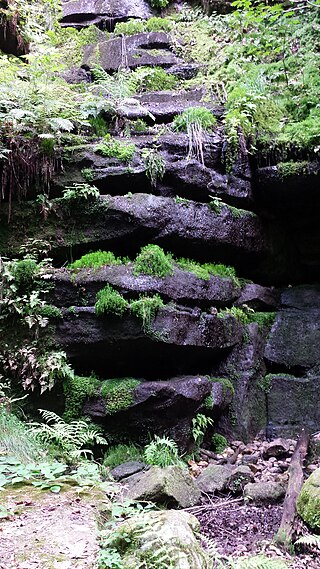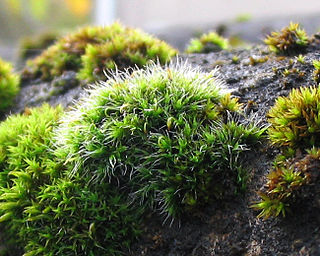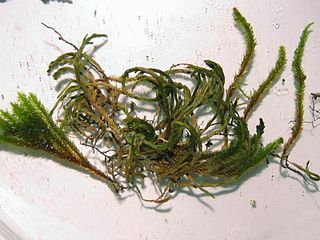
Lycopodium clavatum is the most widespread species in the genus Lycopodium in the clubmoss family.

Amaranthus hypochondriacus is an ornamental plant commonly known as Prince-of-Wales feather or prince's-feather. Originally endemic to Mexico, it is called quelite, bledo and quintonil in Spanish.

Alisma lanceolatum is a species of aquatic plant in the water plantain family known by the common names lanceleaf water plantain and narrow-leaved water plantain. It is widespread across Europe, North Africa and temperate Asia. It is naturalized in Australia, New Zealand, Oregon, California and British Columbia. It is considered a noxious weed in some places.

Tetrodontium brownianum is a species of moss commonly known as Brown's tetrodontium moss or Brown's four-tooth moss. It is widely distributed. In North America it is found in Washington state and British Columbia on the west coast and from Newfoundland to Ohio to the east. It is also present in Austria, France, Germany, Ireland, Norway, Sweden, Switzerland and the United Kingdom as well as Japan, New Zealand and Chile.

Zygodon gracilis, the slender yokemoss, is a moss species in the genus Zygodon. It is a rare lithophyte found to only grow on certain localities of limestone outcrops that has high calcium carbonate content. The current global conservation status of Z. gracilis is considered to be "imperiled".

Selaginella uncinata, the blue spikemoss, peacock moss, peacock spikemoss, or spring blue spikemoss, is a species of plant in the Selaginellaceae family.

Aristolochia reticulata, the Red River snakeroot, Texas Dutchman's pipe, or Texas pipevine, is a species of perennial herb in the family Aristolochiaceae, and endemic to Arkansas, Louisiana, Oklahoma, and Texas. Its habit is erect to sprawling, up to 0.4 meters in height. It flowers in summer and late spring, and summer and grows in moist, sandy soils.

Grimmia pulvinata, otherwise known as grey-cushioned grimmia or pulvinate dry rock moss, is a bryophyte moss common in temperate climates worldwide.

Andreaea rothii, or Roth's andreaea moss, is a species of moss in the family Andreaeaceae native to North America and parts of Europe. This plant was described in 1807 by Weber and Mohr.

Pseudanomodon attenuatus, the tree-skirt moss, poodle moss, or anomodon moss, is a species of moss in the family Neckeraceae or Anomodontaceae, depending on authority. It has a wide-ranging distribution and can be found from Canada to Central America, with a particularly heavy presence in the eastern United States, and the Caribbean as well as in Europe and Asia.

Fissidens limbatus commonly known as Herzog's pocket-moss, is a moss in the family Fissidentaceae. This species is found growing in high elevations in tropical America in addition to the US, Mexico and Canada. Montagne first collected F. crispus in 1838.

Plagiomnium venustum, also known as magnificent leafy moss, is a species of moss belonging to the family Mniaceae. It is found mainly in western North America along the coastal region. This moss can be identified from other members of the Plagiomnium genus by dark coloured stomata guide cells and the absence of sterile stems. It is most commonly found growing as a mat on a variety of substrate, but mainly on humus and moist soil.

Orthotrichum lyellii, also known as Lyell's bristle moss, is a species of acrocarpous moss belonging to the family Orthotrichaceae. O. lyellii can be found throughout western North America and Europe. It is found most commonly growing epiphytically on a variety of trees, and less commonly on rocks or boulder substrates.

Kindbergia praelonga, known as common feather-moss, is a species of moss belonging to the family Brachytheciaceae. It is a medium to large size moss with pinnate leaves. The species is of interest for having properties that may be beneficial for human health.
Hypnum is a genus of mosses belonging to the family Hypnaceae.
Bryocrumia vivicolor is a rheophytic species of moss belonging to the family Hypnaceae, and is the sole representative of the genus Bryocrumia.

Leucodontaceae is a family of mosses belonging to the order Hypnales.

Polytrichum piliferum, the bristly haircap, is an evergreen perennial species of moss in the family Polytrichaceae. The bristly haircap moss is small-sized to medium-sized and forms loose tufts with wine-reddish stems. It is an acrocarpous moss that appears bluish-green to grey. This moss grows in clumps on erect shoots and becomes a red-brown colour as it grows older. The most distinguishing feature of P. piliferum is the long, white awn at the tips of the leaves, which also give this moss its grey colour. It is the only species in its genus where the awn is completely hyaline.

Sphagnum contortum is a species of moss reported in North America and Europe. NatureServe marked its global conservation status as Secure.
Atrichum crispum is a species of moss. It is dioicous with males being the same size as females or larger.

















